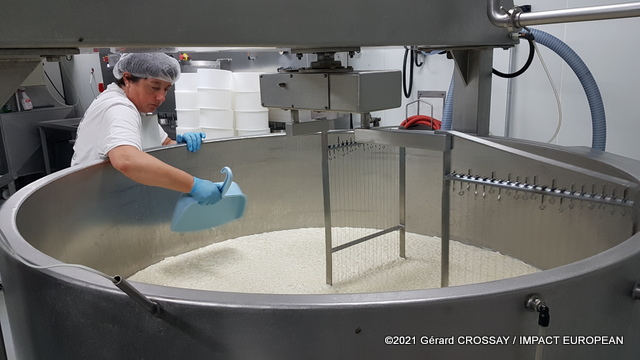The true, the false, the ugly, the beautiful, the hard, the soft …
We immediately think of the Saint-nectaire.
The fake: the « farm cheese » which looks like a brother to the real Saint-Nectaire but which is not produced in the PDO zone (This one straddles the departments of Puy-de-Dôme and Cantal, 69 communities on the lands of the Monts Dore at an altitude of between 800 and 1500 meters).
The ugly … the Saint-nectaire are always beautiful … 21 cm in waist circumference for 1.6 kg.
Hard or soft? … better if it is supple, melting, smooth …
On Sunday August 8, 2021, the 20th edition of the official AOP Saint-Nectaire competition organized by the Interprofession Saint-Nectaire was held in Tauves (63).
THE reference and the unmissable event for all players in the sector.
Nearly 140 cheeses presented by 60 farm producers and a dozen refiners were submitted to the expertise of an experienced jury, chaired this year by Fanny Agostini, famous television presenter, committed to preserving the environment.
The selection criteria for the official competition are those defined in the specifications of the PDO.
The jurors use a very precise score out of 20: 5 points for the appearance, namely its shape and crust, 5 points for the dough – color and texture, and 10 points for the flavor.
After a day of competition, the jury returned its verdict.
- 1st prize Farmer competition: « GAEC le Domaine des Treins » in Tauves (refined by the Société fromagère du Livradois)
- 1st prize Affineurs Challenge: « Terres d’Auvergne » in Besse
But the essential question is the following: How to choose a farm Saint-Nectaire?
It’s a bit like wine, complicated.
Tastes differ according to the producers, the refiners, the season, the weather … and according to the consumers.
… You have to taste! … delicate operation, because, coming out of the refrigerated stalls, the cheeses are too cold and the flavor cannot be appreciated.
When consuming a Saint-Nectaire, it must be left at room temperature at least two hours before … like a wine, it must « open ».
Some criteria are important.
The edge has to be « out of step », a rounding pledge of flexibility.
The paste must be supple, melting in the mouth, smooth, supple, flexing under the finger, combining flavors of hazelnut with notes of cream, ivory color, a good balance between salty, acidity and bitter, aromas mushroom, earth and nuts.
The rind, with the smell of a potato cellar, must be fine, very uniform and sometimes sprinkled with yellow or red flowers when the cheese has matured for more than 7 weeks.
Saint-Nectaire AOP farmer is a cheese made from raw milk from cows raised in a defined geographical area, with a semi-firm, renneted, pressed and salted paste.
It must comply with specifications controlled by an independent body under the control of INAO, the National Institute of Origin and Quality.
Since 1955, it has had the controlled designation of origin (AOC) and, today, the protected designation of origin (AOP).
In the center of one of the 2 sides, it is imperative to find (by scraping the crust) a plate of oval and green casein.
Twenty years ago there were 500 producers. There are only 200 left!
It is a difficult job. 365 days a year, milking a hundred or more cows every morning, every evening, « shearing » …
Some have joined forces with GAEC to be able to take vacations.
Maintaining this activity is important for employment, for the image of Auvergne as well as for the preservation of the landscapes.
Bad cheeses can no longer be found, but finding « very good » ones is less easy because of the standardization of quality due to the excess of health standards imposed by Europe and the INAO which regulate production. , favoring food security at the expense of traditional quality.
Thus, the hygiene services encourage farmers to abandon their natural cellars for artificial cellars with controlled temperature and humidity.
The milks are less rich because of the sanitization of the udders during milking.
Refining on rye straw which gives character is less and less practiced.
Have not the bacteriological standards become too draconian?
We fear this famous « monocytogenic listeria » which sometimes forces the throwing away of an entire production as a health precaution.
All stages of manufacturing are important.
The « cutting », ie the way in which one « cuts » the curd, influences the quality of the dough. It is the job of the cheesemaker, often a cheesemaker, an experienced person with a knack. Unfortunately, this does not exist for all farms.
Refining, a key step which also requires specific know-how with precise gestures passed down from generation to generation … washing, turning, rubbing.
The PDO sector brings together 20 refiners, while around forty producers themselves refine all or part of their production.
The minimum maturing time is 28 days. A bit fair for a cheese lover with character who will have all the trouble in the world to find, both on farms, in cheese factories and in the markets, Saint-Nectaire from 7 to 8 weeks. Especially in summer when demand is too high.
September and October are the best months to enjoy a good Saint-Nectaire chosen with discernment.
The Saint-Nectaire farmer, the nectar of nature.
Share this content:

















Plus d'histoires
Grand Prix de la Pâtisserie: The Edition Where Paris Crowned Resilience
Paris Pastry Grand Prix 2026: “Paris, City of Love” Celebrates Artisan Excellence
Paris Chocolate Show 2025: Innovations, Pastry Creations & Chocolate Performances